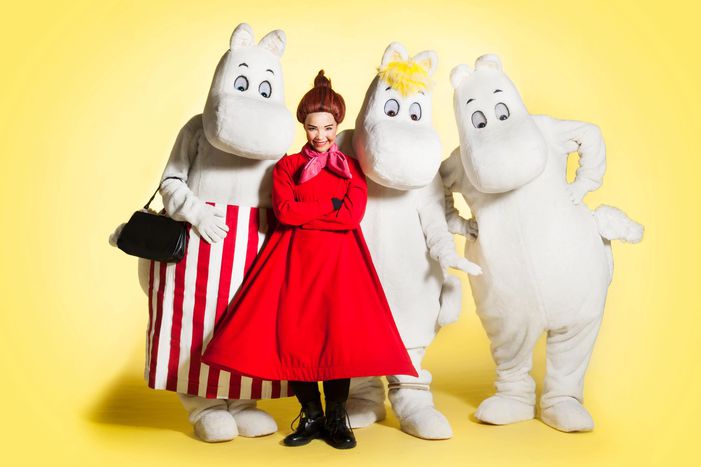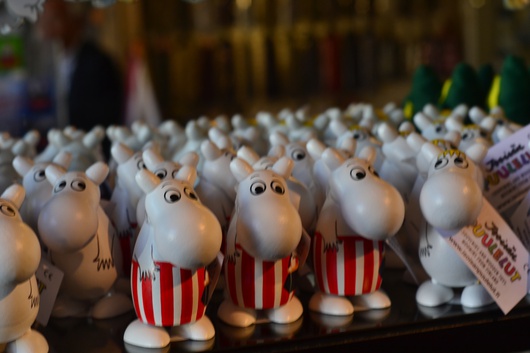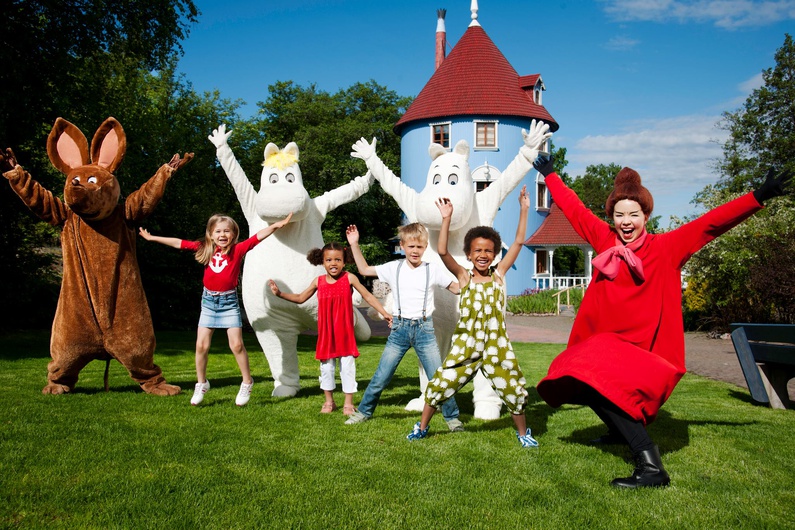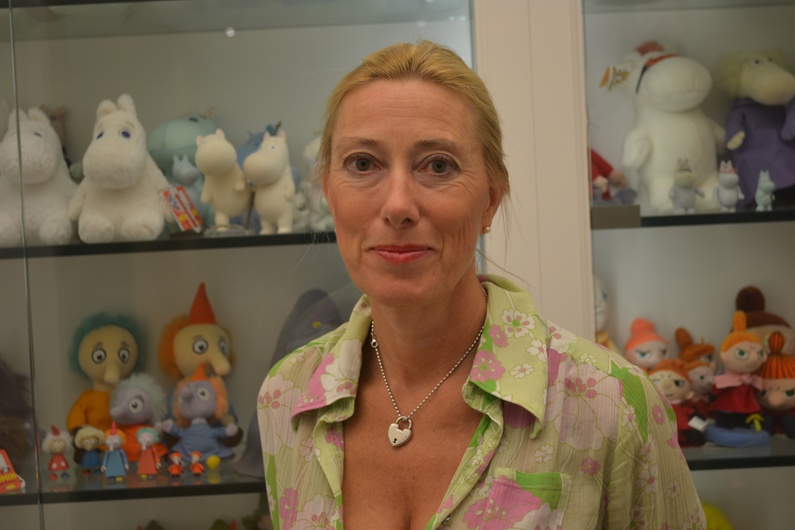
The Moomins are Finland's best ambassadors
Published on
Translation by:
Ceris AstonThe hugely popular cartoon Babar was 'king of elephants' in French children's books, whilst the little mouse Diddl was cuddled by every German child. The Finns cherish strange little creatures with soft purring names. The Moomins represent a veritable utopia for children and a comfort blanket for adults
In Finland the Moomins are everywhere you look – they hang off Volvo keys, are affixed to the windows of banks and cafes, they crowd the sideboards of souvenir shops… With their white silhouettes and their sometimes melancholy, sometimes laughing faces, Moomins are Finland's unofficial mascot. Beloved by old and young alike, they somehow resist the influx of new animated figures such as Angry Birds or Disney characters.
Symbol of Finland
 The Moomins were created by Swedish-speaking Finnish writer Tove Jansson who became a true national heroine for the world her imagination created. Written during the second world war, the Moomin stories are unusually melancholy for children’s books. Following a natural disaster, the Moomin family and their friends are forced to live in a secluded green valley. ‘The Moomins are an important symbol for the Finnish people, partly because they resemble them,’ says Ann-Karin Koskinen, director of marketing at Moominworld, a theme park dedicated to these small creatures. Throughout their adventures, the Moomin family and their friends demonstrate personal qualities and a shared way of life that are deeply inscribed in the Finnish collective consciousness.
The Moomins were created by Swedish-speaking Finnish writer Tove Jansson who became a true national heroine for the world her imagination created. Written during the second world war, the Moomin stories are unusually melancholy for children’s books. Following a natural disaster, the Moomin family and their friends are forced to live in a secluded green valley. ‘The Moomins are an important symbol for the Finnish people, partly because they resemble them,’ says Ann-Karin Koskinen, director of marketing at Moominworld, a theme park dedicated to these small creatures. Throughout their adventures, the Moomin family and their friends demonstrate personal qualities and a shared way of life that are deeply inscribed in the Finnish collective consciousness.
Unlike many fictional characters created for the young, Moomintroll is a complex being. He can ‘be attentive to his friends and spend time with his family’, but he also appreciates ‘solitude, introspection and the experience of being alone surrounded by nature.’ While foreigners know the Moomin world best through animated cartoons, Finns were taught to read with the books of Tove Jansson. Written in good Finnish and full of subtle wordplay and hilarious puns, the books have been passed from generation to generation, still popular sixty years after their publication.
From the beginning of their adventures, Finns took a shine to these blanched hippopotami. The Stockmann department store (the equivalent to Harrods in the UK) devoted a special corner to the Moomins in the 1960s. Since then, they have been reinvented in all kinds of media and sold at an exorbitant price: merchandising (you can revamp your house entirely with Moomin merchandise), animated films, and, in 1992, the creation of Moominworld, an attraction which draws local and foreign visitors alike.
Island refuge
Getting to the park is an adventure in itself. Moominworld is located on an island off the coast from the small town of Naantali, (in the extreme south of Finland - ed). In order to get there visitors must initially set off from Türkü, one of the largest cities in the country. On board a local bus, the view from the window on the fifteen kilometre journey is typical of that of most major cities: discount supermarkets, service stations with diesel at 1.50 euros per litre, signs for overpriced kebabs. After travelling along this road, populated with numerous signs for Moominworld, arrival at the pretty town of Naantali comes as a relief. The park of the Moomins is situated a few metres from the summer residence of the Finnish president and a sixty-year-old sauna.
 Moominworld differs from Disneyland and other European theme parks in pretty much every respect. Here, there are no rollercoasters or little trains, only various children’s entertainments (shows, face-painting and life-sized Moomins) and a summer only opening that limits the economic benefits gained by Mickey Mouse. ‘We wanted to recreate Moominvalley, not invent a place of pure entertainment,’ says Ann-Karin Koskinen. The house of the Moomin family, mounted on four floors and ‘inspired by traditional Finnish dwellings’, is an absolute delight for large and small aficionados of the world. One of the most symbolic places from the cartoon is the lighthouse where Moominpappa isolated himself to write his memoirs. It’s the favourite place of park staff, and usually receives some 400, 000 annual visitors.
Moominworld differs from Disneyland and other European theme parks in pretty much every respect. Here, there are no rollercoasters or little trains, only various children’s entertainments (shows, face-painting and life-sized Moomins) and a summer only opening that limits the economic benefits gained by Mickey Mouse. ‘We wanted to recreate Moominvalley, not invent a place of pure entertainment,’ says Ann-Karin Koskinen. The house of the Moomin family, mounted on four floors and ‘inspired by traditional Finnish dwellings’, is an absolute delight for large and small aficionados of the world. One of the most symbolic places from the cartoon is the lighthouse where Moominpappa isolated himself to write his memoirs. It’s the favourite place of park staff, and usually receives some 400, 000 annual visitors.
While the Moomins are a franchise, they are above all a family. All decisions related to Moomins are endorsed by Sophia Jansson, niece of the illustrator and head of Moomin characters ltd. Everything is immersed in the Moomin universe down to the smallest detail; from Sophia's personalised email signature to the company’s offices, which are located in renovated red-brick factories in Helsinki. ‘According to an American proverb,’ says Sophia, ‘there is the creator of a company, a second generation which develops it, and a third that destroys or sells it. I belong to the second generation!’ She believes that the deep attachment that Finns have for these creatures is primarily because the Moomins resemble them. ‘The Moomins have a great love and respect for nature, which is a particularly Finnish trait. They go for excursions in the forest or to the seaside, as many families here do.’
Finland's greatest ambassadors
Surprisingly the Japanese, who participated in creating the Moomin cartoon in the early 1990s, are an equally receptive audience. Their stories are similar. ‘Finland and Japan were both extensively destroyed after the second world war,’ Sophia Jansson analyses. ‘This contributed to the emergence of a creative generation in the 1950s, which included Tove Jansson.’ Moomin Characters Ltd found a renewed interest in the little creatures following the Fukushima disaster in March 2011. ‘It’s partly because natural disasters are closely linked to the fate of the Moomins, but is probably also because of their ever-optimistic nature. We'd all like to live in this utopian valley.’ Besides Lapland scenery, death metal bands and sauna, Moomins are undoubtedly the best ambassadors of Finland. This isn’t only because of their humanistic qualities and positive aura, but because they accompany the Finns throughout their lives; treasured memories of childhood attached to car keys.
Thanks to Soili Semkina
 This is the last in a series of special monthly city editions on ‘EUtopia on the ground’ following reports ‘dreaming of a better Europe’. This project is funded with support from the European commission via the French ministry of foreign affairs, the Hippocrène foundation and the Charles Léopold Mayer foundation for the progress of humankind
This is the last in a series of special monthly city editions on ‘EUtopia on the ground’ following reports ‘dreaming of a better Europe’. This project is funded with support from the European commission via the French ministry of foreign affairs, the Hippocrène foundation and the Charles Léopold Mayer foundation for the progress of humankind
Translated from Finlande : les Moumines, poupée de soi



